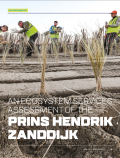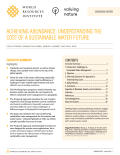
Based on preliminary identification of environmental priorities, this report explores selected topics that aim to inform decision-making in the Yucatán Peninsula. A general context of integrated coastal zone management (ICZM) is used to explore issues, constraints, and potential solutions. The role of geomorphology is examined with a view to identifying how shore management plans can contribute to improved coastal management. The report also demonstrates how rigorous economic tools can provide insights into the economic impacts of extreme climate events and of economic losses from environmental degradation. It concludes with options for consideration in the years ahead in relation to pilot projects and interventions, technical assistance, institutional strengthening, and monitoring, evaluation, research, and development.

This study examines which and, if possible, how much more ecosystem services are provided by the most recent nature inspired coastal protection project Prins Hendrik Zanddijk, in comparison with a traditional concrete and asphalt construction.

Among the identified pathways in the 2018 IPCC report for keeping warming below either 2.0°C or 1.5°C, almost all require the deployment of still speculative carbon removal and storage methods. However, most carbon removal methods remain at the preliminary research and assessment stage, with a great deal of uncertainty over their technical feasibility, social acceptability, cost, and associated impacts. In addition, some argue that the reliance on unproven carbon removal methods to fulfill climate policy goals creates a false sense of complacency about the need for an immediate and aggressive transition away from fossil fuels. This report looks at why the entire field of carbon removal needs additional scrutiny and how to build a better carbon removal conversation.

This report critically assesses how peacebuilding programming can also produce adaptation benefits (and vice versa), so that interventions simultaneously contribute to reduced intercommunal conflict and strengthened resilience to a range of shocks and stresses, including droughts, floods, and rainfall variability.

This Paper proposes a method whereby any decision-maker can calculate the cost required to deliver sustainable water management to a geography. It calculates the cost of action required to close the gap between current conditions and desired conditions to financially compare and prioritize different water-related challenges or different targets of Sustainable Development Goal 6. The paper also estimates the costs of delivering sustainable water management for all countries and major basins.
